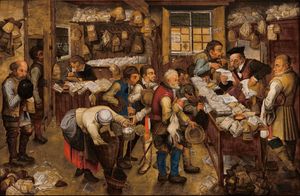العشر (ضريبة)

العشر (tithe ؛ /ˈtaɪð/؛ من الإنگليزية القديمة: teogoþa "عـُشر") هي عـُشـْر الشيء، ويُدفع كمساهمة في مؤسسة دينية أو كضريبة إلزامية للحكومة.[1] Today, tithes are normally voluntary and paid in cash, cheques, or stocks, whereas historically tithes were required and paid in kind, such as agricultural products. Several European countries operate a formal process linked to the tax system allowing some churches to assess tithes.
العشر هي ضريبة على التاجر تشبه ضريبة الجمارك في أيامنا الحاضرة واتبعت الدولة العربية الإسلامية مبدأ المعاملة بالمثل للتجار الأجانب ، فكانت تأخذ العشر من رعاياها الأجانب ونصف العشر من أهل الذمة وربع العشر من المسلمين وشريطه بلوغ ثمن السلعة مائتين فأكثر.
Traditional Jewish law and practice has included various forms of tithing since ancient times. Orthodox Jews commonly practice ma'aser kesafim (tithing 10% of their income to charity). In modern Israel, Jews continue to follow the laws of agricultural tithing, e.g., ma'aser rishon, terumat ma'aser, and ma'aser sheni. In Christianity, some interpretations of Biblical teachings conclude that although tithing was practiced extensively in the Old Testament, it was never practiced or taught within the first-century Church. Instead, the New Testament scriptures are seen as teaching the concept of "freewill offerings" as a means of supporting the church: 1 Corinthians 16:2, 2 Corinthians 9:7. Also, some of the earliest groups sold everything they had and held the proceeds in common to be used for the furtherance of the Gospel: Acts 2:44-47, Acts 4:34-35. Further, Acts 5:1-20 contains the account of a man and wife (Ananias and Sapphira) who were living in one of these groups. They sold a piece of property and donated only part of the selling price to the church but claimed to have given the whole amount and immediately fell down and died when confronted by the apostle Peter over their dishonesty.
Tithes were mentioned at the Council of Tours in 567 and the Synod of Mâcon in 585. They were formally recognized under Pope Adrian I in 787.[بحاجة لمصدر]
الشرق الأدنى القديم
None of the extant laws of the Ancient Near East deal with tithing, although other secondary documents show that it was a widespread practice in the Ancient Near East.[2] William W. Hallo (1996[3]) recognises comparisons for Israel with its ancient Near Eastern environment, however, as regards tithes, comparisons with other ancient Near Eastern evidence is ambiguous,[4] and Ancient Near Eastern literature provides scant evidence for the practice of tithing and the collection of tithes.[5]
The esretu — "ešretū" the Ugarit and Babylonian one-tenth tax
Listed below are some specific instances of the Mesopotamian tithe, taken from The Assyrian Dictionary of the Oriental Institute of the University of Chicago, Vol. 4 "E" pag.369,:[6]
- [Referring to a ten per cent tax levied on garments by the local ruler:] "the palace has taken eight garments as your tithe (on 85 garments)"
- "...eleven garments as tithe (on 112 garments)"
- "...(the sun-god) Shamash demands the tithe..."
- "four minas of silver, the tithe of [the gods] Bel, Nabu, and Nergal..."
- "...he has paid, in addition to the tithe for Ninurta, the tax of the gardiner"
- "...the tithe of the chief accountant, he has delivered it to [the sun-god] Shamash"
- "...why do you not pay the tithe to the Lady-of-Uruk?"
- "...(a man) owes barley and dates as balance of the tithe of the **years three and four"
- "...the tithe of the king on barley of the town..."
- "...with regard to the elders of the city whom (the king) has **summoned to (pay) tithe..."
- "...the collector of the tithe of the country Sumundar..."
- "...(the official Ebabbar in Sippar) who is in charge of the tithe..."
التوراة
Hebrew is a Semitic language, related to Akkadian, the lingua franca of that time.[7]
المسيحية
المسيحية الأرثوذكسية
Tithing in medieval Eastern Christianity did not spread so widely as in the West. A Constitution of the Emperors Leo I (reigned 457-474) and Anthemius (reigned 467-472) apparently expected believers to make voluntary payments and forbade compulsion.[8]
المورمون
The Church of Jesus Christ of Latter-day Saints (LDS Church) bases its tithing on the following additional scriptures:[9]
الإسلام
Zakāt (العربية: زكاة [zækæːh]) or "alms giving", one of the Five Pillars of Islam, is the giving of a small percentage of one's assets to charity. It serves principally as the welfare contribution to poor and deprived Muslims, although others may have a rightful share. It is the duty of an Islamic state not just to collect zakat but to distribute it fairly as well.
السيخية
Daswandh (Punjabi: ਦਸਵੰਧ), sometimes spelled Dasvandh, is the one tenth part (or 10%) of one's income that should be donated in the name of the God, according to Sikh principles.[10][11]
انظر أيضاً

- Church of the Tithes in Kiev
- Council on the Disposition of the Tithes
- Peter's Pence
- Status of religious freedom by country
- Tithe: A Modern Faerie Tale novel by Holly Black
- Tithing
- Tithing (country subdivision)
- Zakat the Islamic concept of tithing and alms
الهامش
- ^ David F. Burg (2004). A World History of Tax Rebellions. pp. viii.
- ^ D. L. Baker, Tight fists or open hands?: wealth and poverty in Old Testament law (2009) Page 239. "This was provided by means of a tithe of agricultural produce. a. Tithes in the Ancient Near East None of the extant laws deal with tithing, though other documents show that it was a widespread practice in the ancient Near East."
- ^ WW Hallo, Origins: The Ancient Near Eastern Background of Some Modern Western Institutions (Studies in the History and Culture of the Ancient Near East VI; Leiden/New York/Köln)
- ^ Menahem Herman Tithe as gift: the institution in the Pentateuch and in light of ... 1992 Page 127 "Hallo recognizes comparisons for Israel with its ancient Near Eastern environment. However, in the instance of the tithe, comparisons with other ancient Near Eastern evidence has already been shown to be ambiguous, given the lack of ..."
- ^ Bertil Albrektson, Remembering all the way--: a collection of Old Testament studies (1981) Page 116. "THE TITHES IN THE OLD TESTAMENT BY H. JAGERSMA Brussels I. Introduction "In the Old Testament as well as in other Ancient Near Eastern literature, we find only scant evidence for the practice of tithing and the collection of tithes."
- ^ https://OI.UCHICAGO.EDU/SITES/OI.UCHICAGO.EDU/FILES/UPLOADS/SHARED/DOCS/CAD_E.PDF
- ^ Joshua A. Berman Created Equal: How the Bible Broke With Ancient Political Thought 2008 Page 92 "Cognates of the Hebrew word for tithe, ma'a ̆ser, likewise connote activities of taxation elsewhere in the ancient Near East. In Ugarit, the ma's ̆aru or mas ̆ertu was a payment consisting of a tenth of products of the field and on ..."
- ^
Сильвестрова, Е. В. (2012-03-24). "ДЕСЯТИНА" [Tithe]. In Gundyayev, Vladimir Mikhailovich (ed.). Православная энциклопедия [Orthodox encyclopedia] (in Russian). Vol. 14 (Electronic version ed.). Церковно-научный центр «Православная Энциклопедия». pp. 450–452. Retrieved 2015-01-23.
На Востоке Д[есятина] не получила такого распространения, как на Западе. Известна, в частности, конституция императоров Льва и Антемия, в которой священнослужителям запрещалось принуждать верующих к выплатам в пользу Церкви под угрозой различных прещений. Хотя в конституции не употребляется термин decima, речь идет о начатках и, по всей видимости, о выплатах, аналогичных Д., к-рые, по мнению императоров, верующие должны совершать добровольно, без всякого принуждения [...].
{{cite encyclopedia}}: CS1 maint: unrecognized language (link) - ^ "Lesson 44: Malachi Teaches about Tithes and Offerings", Primary 6: Old Testament, LDS Church, 1996, pp. 196–201, http://www.lds.org/manual/primary-6-old-testament/lesson-44-malachi-teaches-about-tithes-and-offerings
- ^ "Daswandh". www.encyclopedia.com. Retrieved 20 January 2012.
- ^ "Daswandh - Gateway to Sikhism". www.allaboutsikhs.com. Retrieved 20 January 2012.
المراجع
- Albright, W. F. and Mann, C. S. Matthew, The Anchor Bible, Vol. 26. Garden City, New York, 1971.
- The Assyrian Dictionary of the Oriental Institute of the University of Chicago, Vol. 4 "E." Chicago, 1958.
- Fitzmyer, Joseph A. The Gospel According to Luke, X-XXIV, The Anchor Bible, Vol. 28A. New York, 1985.
- Grena, G.M. (2004). LMLK--A Mystery Belonging to the King vol. 1. Redondo Beach, California: 4000 Years of Writing History. ISBN 0-9748786-0-X.
- Speiser, E. A. Genesis, The Anchor Bible, Vol.1. Garden City, New York, 1964.
- Kelly, Russell Earl, "Should the Church Teach Tithing? A Theologian's Conclusions about a Taboo Doctrine," IUniverse, 2001.
- Matthew E. Narramore, "Tithing: Low-Realm, Obsolete & Defunct" - April 2004 - (ISBN 0-9745587-02)
- Croteau, David A. "You Mean I Don't Have to Tithe?: A Deconstruction of Tithing and a Reconstruction of Post-Tithe Giving" (McMaster Theological Studies)
للاستزادة
- Gower, Granville William Gresham Leveson- (1883). . Rochester: Rochester Diocese.
وصلات خارجية
- Theologian Russell Kelly on tithing
- Tithing at the Open Directory Project
- Q & A On Tithing By Russ Kelly
- Articles By New Testament Scholar Dr. David Croteau
- The Tithe Debate - Arguments For and Against Christian Tithing Today
- A brief history of tithes in England at the Wayback Machine (archive index)
- Do Christian Tithe?
